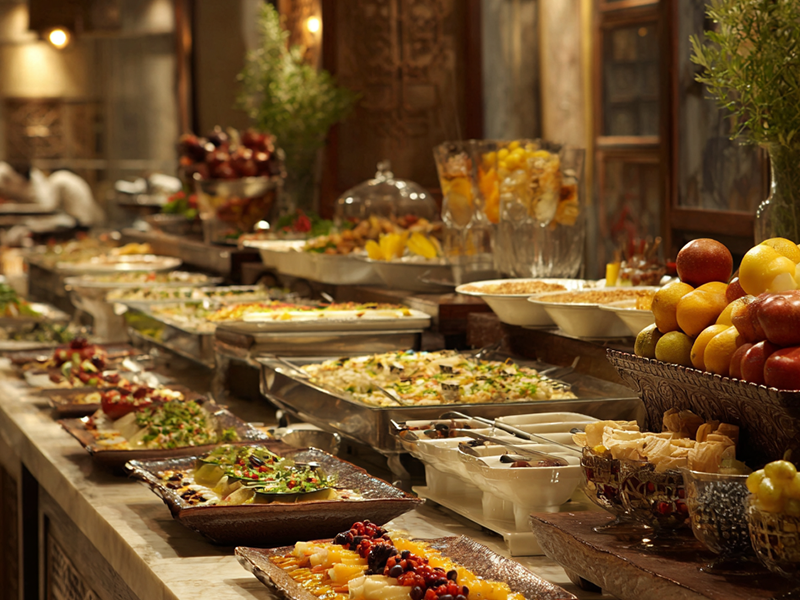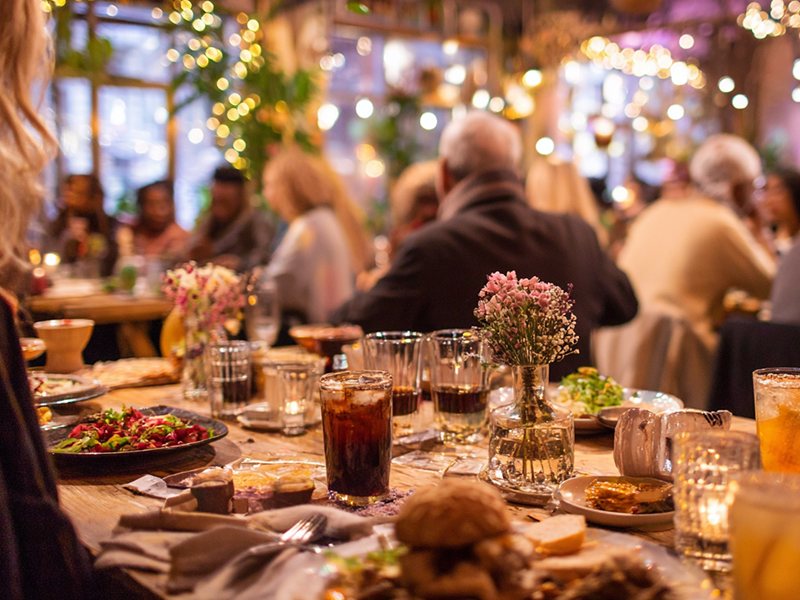By Katrin Krakovich, CEO of Lahav Media
Your restaurant website might look gorgeous, but if it's invisible on Google, it's basically a digital ghost town. I've watched too many incredible restaurants struggle with empty tables while their competitor down the street (who honestly makes mediocre pasta) stays packed because they nailed their restaurant website SEO.
Here's the truth: your website isn't just a pretty brochure anymore. It's your 24/7 sales machine, review magnet, and the first impression for 90% of your potential customers. But most restaurant owners treat SEO like some mysterious black magic that only tech wizards understand.
Let me change that for you.
Why Your Restaurant's SEO Matters More Than Ever
Remember when people used to drive around looking for a good place to eat? Those days are dead. Now, 97% of consumers search online for restaurants before stepping foot inside. Even worse, if you're not on the first page of Google, you might as well be invisible.
I've seen family-owned cafes with incredible food lose customers to chain restaurants simply because the chains knew how to show up in search results. That's not just frustrating – it's fixable.

The Foundation: Technical SEO Basics Every Restaurant Needs
Speed Matters (Seriously, Every Second Counts)
Your website needs to load in under 3 seconds, or hungry customers will bounce faster than a bad check. I've tested this with dozens of restaurant clients, and the difference between a 2-second load time and a 5-second load time can mean 40% fewer reservations.
Check your site speed using Google PageSpeed Insights. If you're scoring below 80, you're hemorrhaging customers before they even see your menu.
Mobile-First or Mobile-Last?
Here's a wake-up call: 73% of restaurant searches happen on mobile phones. If your website looks like garbage on a smartphone, you're essentially telling three-quarters of your potential customers to eat somewhere else.
Your mobile site should load instantly, display your menu clearly, and make it ridiculously easy to find your phone number, address, and hours. No pinching and zooming to read microscopic text.
Local SEO: The Secret Sauce for Restaurant Success
Google Business Profile Optimization
This is where most restaurants completely drop the ball. Your Google Business Profile isn't just a listing – it's prime real estate that can make or break your local visibility.
Essential elements that most restaurants mess up:
Your business name should match exactly what's on your storefront and website. "Mario's Pizza" and "Mario's Famous New York Style Pizza & Italian Restaurant" are two different things to Google.
Categories matter more than you think. Choose your primary category carefully (Restaurant, Pizza Place, Coffee Shop, etc.), then add 2-3 secondary categories that accurately describe what you offer.
Hours must be updated religiously. Nothing kills trust faster than showing up to a "closed" restaurant that Google said was open.
Photos should include your storefront, interior, signature dishes, and happy customers. Upload at least 20 high-quality images, and refresh them monthly.

The Review Management Game
Let's be honest – reviews can make you or break you. But here's what most restaurant owners don't realize: it's not just about getting five-star reviews. It's about responding to ALL reviews (yes, even the nasty ones) and getting a steady stream of fresh feedback.
Google loves businesses that actively engage with customers. A restaurant that responds thoughtfully to reviews ranks higher than one that ignores them, even if the latter has better ratings.
On-Page SEO: Making Every Page Work Harder
Your Homepage Strategy
Your homepage needs to accomplish three things in the first 10 seconds: tell visitors exactly what type of restaurant you are, where you're located, and why they should choose you over the competition.
Include your primary keyword (like "Italian restaurant in downtown Portland") in your title tag, H1 heading, and naturally throughout your content. But don't stuff keywords like you're making sausage – Google is smarter than that now.
Menu Page Optimization
Your menu page is probably getting more traffic than any other page on your site, so don't waste that opportunity. Each menu section should have descriptive headings, and popular dishes should include brief, appetizing descriptions with relevant keywords.
Instead of just listing "Margherita Pizza," try "Wood-fired Margherita Pizza with San Marzano tomatoes and fresh basil." It helps with search rankings AND makes mouths water.
Location and Hours Pages
Create dedicated pages for each location if you have multiple spots. Include detailed information about parking, public transit, nearby landmarks, and what makes each location unique.
For single-location restaurants, your contact page should be a local SEO powerhouse. Include your full address, phone number, hours of operation, and embed a Google Map. Mention nearby neighborhoods, landmarks, and even cross-streets.
Content Marketing That Actually Drives Reservations
Blog Topics That Work for Restaurants
Skip the generic "5 Benefits of Eating Organic" posts. Instead, write about topics your local customers actually search for:
"Best Date Night Spots in [Your City]" and position yourself as one of them "How to Host a Private Party in [Your Neighborhood]" if you offer event space
"The Story Behind Our Signature [Dish Name]" for unique menu items "What to Expect at [Restaurant Name]: A First-Timer's Guide"
Local Event and Seasonal Content
Smart restaurants create content around local events, seasons, and holidays. Write about your special Valentine's Day menu, what makes your restaurant perfect for graduation parties, or why you're the ideal spot to celebrate after the local team wins.
Coffee shops can write about the perfect fall drinks for local weather, while bars might focus on the best happy hour deals for the after-work crowd.

Schema Markup: The Technical Boost Most Restaurants Ignore
This is the nerdy stuff that makes a huge difference. Schema markup is code that helps Google understand exactly what your business offers. It's how you get those rich snippets showing your hours, ratings, and menu items directly in search results.
At minimum, implement LocalBusiness schema, Menu schema, and Review schema. Most restaurant owners skip this step, which means you can get a significant advantage just by doing what your competitors won't.
AI Search Optimization: Preparing for the Future
ChatGPT, Google's AI Overview, and other AI tools are changing how people discover restaurants. These systems pull information from websites to answer questions like "best romantic restaurants near me" or "places with good vegetarian options in downtown."
To show up in AI-generated answers, your website content needs to directly answer common questions. Create FAQ sections, write in a conversational tone, and include specific details about your offerings.
Common SEO Mistakes That Kill Restaurant Visibility
The Stock Photo Trap
Nothing screams "generic chain restaurant" like stock photos of perfect food that you definitely don't serve. Use real photos of your actual dishes, taken in your actual restaurant. They don't have to be professionally shot, but they need to be authentic.
Ignoring Local Keywords
Optimizing for "pizza restaurant" when you should be targeting "deep dish pizza Chicago" or "wood-fired pizza downtown Seattle" is like fishing in the ocean when all the fish are in the lake next door.
Inconsistent NAP Information
NAP stands for Name, Address, Phone number. If this information doesn't match exactly across your website, Google Business Profile, Yelp, and other directories, search engines get confused and your rankings suffer.
The Monthly SEO Maintenance Routine
SEO isn't a one-and-done project. Set aside time each month to:
Update your Google Business Profile with new photos and posts Check and respond to new reviews across all platforms Update your website with current hours, menu changes, and seasonal offerings Review your search rankings for key local terms Audit your website for broken links and outdated information
When to Call in the Professionals
If you're a restaurant owner reading this thinking "I barely have time to prep for dinner service, let alone optimize schema markup," you're not alone. The most successful restaurant owners I know focus on what they do best – creating amazing food and experiences – and delegate marketing to experts who eat, sleep, and breathe this stuff.
Look for a marketing agency that specializes in restaurants and understands the unique challenges of the food service industry. They should be able to show you exactly how their work translates to more reservations, takeout orders, and foot traffic.
At Lahav Media, we've built our entire practice around helping restaurants, cafes, and coffee shops dominate their local search results. We understand that every minute you spend wrestling with SEO technicalities is time taken away from what you do best – creating incredible dining experiences (and honestly, nobody wants their chef googling "schema markup" at 2 AM). Our team handles everything from Google Business Profile optimization and review management to comprehensive website SEO and AI search preparation, so you can focus on running your restaurant while we focus on filling your tables. Think of us as your digital sous chef, except we specialize in serving up search rankings instead of soufflés.
Frequently Asked Questions

-p-500.jpg)
